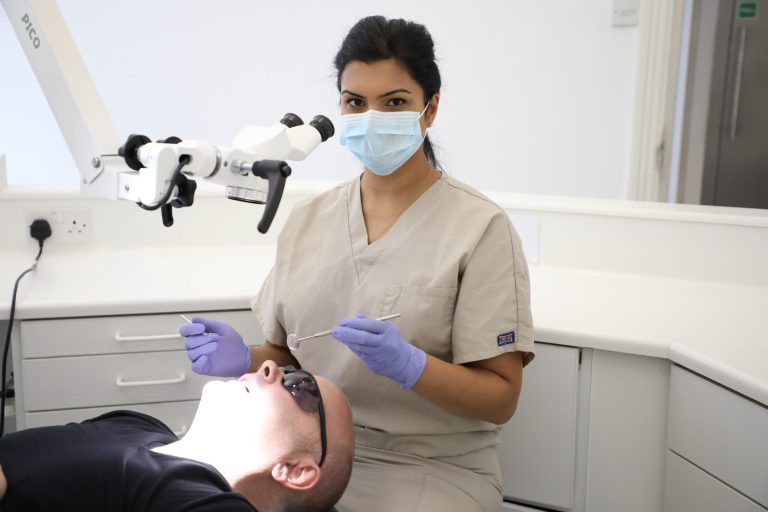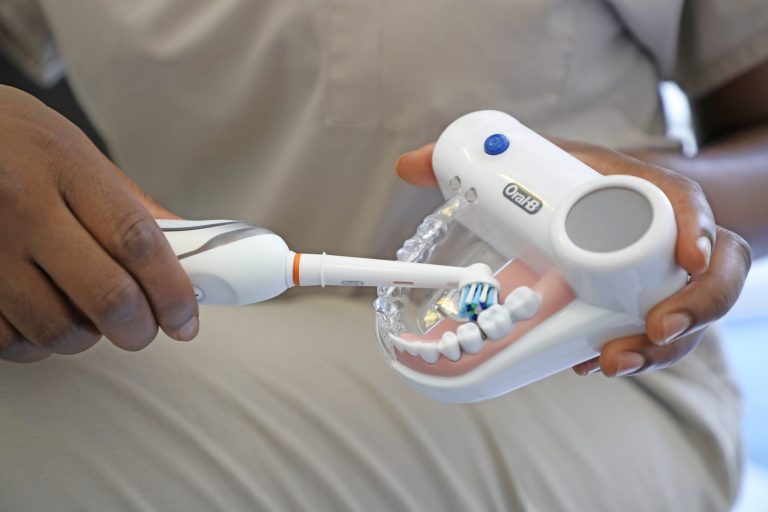
At London Dental Specialists: Our Dental Clinic in London, England, United Kingdom, we specialise in advanced bone grafting procedures to restore and enhance your jaw bone structure for successful dental implant placement. Bone grafting is a sophisticated surgical technique that replaces missing bone tissue, creating a strong foundation for dental restorations whilst promoting natural bone regeneration.Our expert dental surgeons utilise various bone grafting materials, including autografts (your own bone tissue), allografts, and synthetic materials, each carefully selected based on your specific needs. The procedure involves precisely placing the grafting material where bone density is insufficient, stimulating your body's natural healing response through three key biological processes: osteoconduction, osteoinduction, and osteogenesis.Whether you require minor grafting for a single implant or extensive jaw reconstruction, our state-of-the-art clinic provides comprehensive bone augmentation solutions. We employ advanced imaging technology to precisely plan your treatment, ensuring optimal results for dental implant placement. Our careful approach includes thorough pre-operative assessment, gentle surgical techniques, and dedicated post-operative care to support your healing journey.


Our comprehensive bone grafting treatment follows a carefully structured process designed to restore and enhance your jaw bone density. Beginning with a thorough consultation and assessment, our specialists evaluate your unique dental needs using advanced imaging techniques to determine the precise grafting requirements. We then develop a personalised treatment plan, selecting the most suitable grafting material and approach for your case. The procedure itself is performed under appropriate anaesthesia, where the grafting material is precisely placed to encourage natural bone regeneration. Following treatment, we provide detailed aftercare guidance and schedule regular follow-up appointments to monitor your healing progress, ensuring optimal results for future dental work such as implants.
The initial bone grafting consultation at London Dental Specialists begins with a comprehensive oral examination and detailed assessment of your jaw bone structure. Our specialist dental team will evaluate your specific needs using advanced imaging techniques to determine the extent of bone loss and create a personalised treatment plan.
During your consultation, we will:
Our specialists will conduct a thorough examination of your:
The consultation includes a detailed discussion of your treatment goals and expectations. We'll explain the different types of bone grafting materials available, including:
Following your assessment, you'll receive a personalised treatment plan outlining the recommended procedure, expected timeline, and post-operative care instructions. We ensure you have all the information needed to make an informed decision about your bone grafting procedure.

Our custom bone grafting treatment plan begins with a comprehensive evaluation of your jaw's bone density and structure. During this phase, we meticulously analyse your specific needs to create a personalised approach for optimal bone regeneration.
The treatment plan encompasses several key components:
We carefully consider the following factors when developing your bone grafting plan:
| Assessment Factor | Purpose |
|---|---|
| Current bone density | Determines the extent of grafting needed |
| Jaw location | Influences grafting technique selection |
| Overall oral health | Affects healing potential and timeline |
Your personalised treatment plan will outline the specific type of bone graft recommended for your case, which may include:
We'll provide you with a detailed healing timeline and explain each stage of the recovery process, typically spanning 3-6 months, depending on your individual case and the type of graft used.

Bone grafting treatment at London Dental Specialists involves a precise surgical procedure where we add bone material to strengthen your jaw in preparation for dental implants. This essential procedure creates a solid foundation for successful implant placement when natural bone density is insufficient.
The treatment procedure follows these carefully managed steps:
The healing process typically requires 3-6 months, during which the grafted material integrates with your natural bone through a process called osteoconduction. This biological process creates new, strong bone tissue suitable for dental implant placement.
Our specialists utilise various types of grafting materials, including:
Following your procedure, we provide comprehensive aftercare instructions and schedule regular check-ups to monitor your healing progress. Most patients can return to their normal activities within a few days, though complete bone regeneration takes several months.

Post-treatment care for bone grafting requires careful attention to ensure optimal healing and successful integration of the graft material. Following your procedure at London Dental Specialists, proper aftercare is essential for the best possible outcomes.
During the initial 24-48 hours after surgery, you should:
For the first week following treatment, we recommend:
Long-term aftercare guidelines include:
Should you experience any concerns or complications, our team at London Dental Specialists is available to provide support and guidance. We offer a 10-year warranty on dental implants for your peace of mind.
Warning signs to watch for include:






Bone grafting is a surgical procedure that rebuilds or strengthens areas of weakened jawbone, typically performed before dental implant placement. When teeth are missing, the surrounding bone can deteriorate over time, making it too thin or soft to securely hold dental implants. This procedure creates a more solid foundation by adding bone material to your jaw, either from your own body, donor tissue, or synthetic materials.
The need for bone grafting often arises when there's significant bone loss due to previous tooth extractions, gum disease, or trauma. Without adequate bone density, dental implants cannot be properly anchored, much like how a house needs a strong foundation to remain stable. The grafting procedure helps restore both the height and width of your jawbone to its optimal dimensions.
Typical healing timeline:
Post-procedure care includes:
At London Dental Specialists, we provide a 10-year warranty on dental implants and endodontics, ensuring long-term peace of mind for our patients following their bone grafting procedure.
A bone grafting procedure typically takes between 45-90 minutes to complete, depending on the complexity and amount of grafting material needed. During the surgery, your dentist will first administer local anaesthesia to ensure you're comfortable, then make a small incision in your gum to access the bone that needs augmentation.
The surgical process involves carefully placing bone grafting material into the targeted area of your jaw. This material can be synthetic, derived from human donor tissue, or in some cases, taken from another part of your own body. The graft is then secured in place and the gum tissue is sutured closed.
Post-surgery care is crucial for optimal healing. Most patients can return to their normal activities within a few days, though complete bone integration typically takes 3-6 months. Our 10-year warranty on dental implants provides peace of mind for your long-term oral health investment.
| Recovery Timeline | Activity Level |
|---|---|
| First 24-48 hours | Rest and minimal activity |
| 3-7 days | Return to normal daily activities |
| 2-3 weeks | Soft tissue healing complete |
| 3-6 months | Complete bone integration |
Dental bone grafting materials come in four main types: autografts (from your own body), allografts (from human donors), xenografts (from animals), and alloplasts (synthetic materials). Each type serves as a scaffold to support new bone growth in areas where additional bone volume is needed for dental procedures such as implants.
The choice of grafting material depends on various factors including the location and extent of bone loss, as well as individual patient considerations. While autografts are considered the gold standard due to their natural bone-growing properties, processed donor materials have become increasingly popular due to their availability and elimination of a second surgical site.
At London Dental Specialists, we provide a 10-year warranty on dental implants and endodontics, ensuring long-term peace of mind for our patients following bone grafting procedures.
The bone graft recovery and healing process typically spans 3-6 months, during which new bone tissue gradually forms and integrates with existing bone. Initially, you'll experience some swelling and mild discomfort for the first few days, which can be managed with prescribed pain medication and cold compresses. Most patients can return to their normal daily activities within a week, though strenuous exercise should be avoided for several weeks.
The healing process occurs in stages, beginning with an initial inflammatory response that helps initiate bone regeneration. Over the following weeks, new blood vessels form within the grafted area, and bone-forming cells begin producing new bone tissue. This process, known as osseointegration, continues gradually until the graft fully integrates with your natural bone.
Our 10-year warranty on dental implants provides peace of mind throughout your healing journey. Should you experience any concerns during recovery, our specialist team is available to provide support and guidance.
Dental bone grafting procedures, while generally safe, can involve certain potential risks and complications that patients should be aware of. The most common complications include infection at the surgical site, bleeding, and temporary swelling or discomfort. In rare cases, patients may experience nerve damage, sinus complications (particularly with upper jaw grafts), or rejection of the grafting material.
The severity and likelihood of complications largely depend on factors such as the type of bone graft used, the location of the procedure, and the patient's overall health condition. Most complications are manageable and resolve with proper care and monitoring.
At London Dental Specialists, we provide comprehensive post-operative care instructions and offer a 10-year warranty on dental implants and endodontics. Patients should contact us immediately if they experience severe pain, excessive bleeding, or signs of infection during recovery.
| Recovery Timeline | Expected Progress |
|---|---|
| First 24-48 hours | Initial swelling and minor discomfort |
| First week | Gradual reduction in swelling and discomfort |
| 2-3 months | Bone graft integration period |
Bone grafting is a surgical procedure that rebuilds and strengthens areas of weakened jawbone, typically performed before dental implant placement. The process involves adding bone material to your jaw, which then integrates with your natural bone over time to create a sturdy foundation for dental implants or other restorative procedures.
The procedure can use different types of bone grafting materials, including your own bone (autograft), donor bone (allograft), or synthetic materials (alloplast). Each type offers unique benefits, with the choice depending on your specific clinical needs and the amount of bone regeneration required.
Typical healing timeline:
Post-procedure care:
Our 10-year warranty on dental implants provides peace of mind for your bone grafting and subsequent implant treatment. Should you experience any concerns during recovery, our specialist team is available to provide support and guidance.
While some patients can receive dental implants without bone grafting, it largely depends on your existing jaw bone density and quality. The jawbone needs adequate volume and density to securely hold the implant in place. A thorough examination, including detailed X-rays or CT scans, is necessary to determine if you have sufficient bone structure for a successful implant.
Bone grafting becomes necessary when there isn't enough healthy bone to support an implant, often due to tooth loss, gum disease, or injury. This preparatory procedure creates a solid foundation for dental implants by adding bone material to your jaw, ensuring long-term implant stability.
At London Dental Specialists, we provide comprehensive post-treatment support and a 10-year warranty on dental implants. Most patients report minimal discomfort during recovery, which can be managed with prescribed pain medication. Regular follow-up appointments ensure proper healing and integration of the bone graft.
| Recovery Milestone | Timeline |
|---|---|
| Initial healing | 2-3 weeks |
| Bone integration | 3-6 months |
| Ready for implant placement | 4-9 months (depending on graft type) |
Bone grafting is a surgical procedure that rebuilds and strengthens areas of weakened jawbone, typically performed before dental implant placement. This essential treatment creates a solid foundation by adding bone material to areas where natural bone has been lost due to injury, gum disease, or tooth loss.
The procedure involves carefully placing bone grafting material into the weakened area of the jaw, which then stimulates natural bone regeneration over time. This new bone growth provides the necessary support for dental implants or other restorative treatments.
Typical healing timeline:
Post-procedure care:
Our 10-year warranty covers dental implants placed following bone grafting procedures, ensuring long-term peace of mind for our patients.

To schedule a bone grafting consultation at London Dental Specialists, simply contact our clinic directly by phone or email. Our experienced team will arrange a comprehensive consultation where we'll assess your specific needs and discuss the most suitable bone grafting approach for your case.
During your initial consultation, our specialists will perform a thorough examination, including X-rays and 3D scans if necessary, to evaluate your bone density and determine the type of bone graft needed. We'll explain the procedure in detail, including recovery timelines and post-operative care instructions.
Our clinic provides a 10-year warranty on dental implants and endodontics, giving you peace of mind about your investment in oral health.
At London Dental Specialists, we understand that bone grafting procedures can represent a significant investment in your oral health. The cost of bone grafting in London typically ranges from £400 to £3,000, depending on the type and complexity of the procedure. For detailed information about financing options and payment plans tailored to your specific treatment needs, we encourage you to contact our treatment coordinators.
Our team is committed to making your bone grafting treatment as accessible as possible while maintaining the highest standards of care. During your consultation, we'll provide a comprehensive treatment plan with a detailed cost breakdown and discuss all available payment arrangements.
Contact our friendly team today to schedule your consultation and learn more about our payment options. We're here to help make your bone grafting treatment journey as smooth as possible.
The key factors determining your suitability for bone grafting primarily depend on your overall oral health, bone density in your jaw, and specific dental needs. Candidates typically include those who have experienced bone loss due to tooth loss, gum disease, or trauma, and are looking to receive dental implants or restore their oral structure.
A thorough evaluation of your medical history, including conditions like diabetes or osteoporosis, smoking habits, and current medications, is essential to determine if you're an ideal candidate. Your healing capacity and commitment to maintaining good oral hygiene are also crucial factors.
At London Dental Specialists, we provide comprehensive evaluations using advanced imaging technology to assess your specific needs. Our 10-year warranty on dental implants offers peace of mind for your long-term oral health investment.